Related Research Articles

Illuminati: New World Order (INWO) is an out-of-print collectible card game (CCG) that was released in 1994 by Steve Jackson Games, based on their original boxed game Illuminati, which in turn was inspired by the 1975 book The Illuminatus! Trilogy by Robert Anton Wilson and Robert Shea. An OMNI sealed-deck league patterned after the Atlas Games model was also developed.
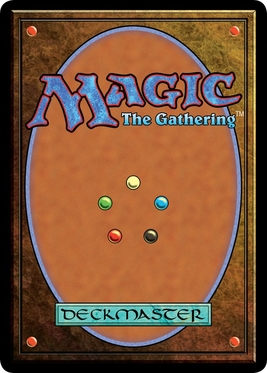
Magic: The Gathering is a tabletop and digital collectible card game created by Richard Garfield. Released in 1993 by Wizards of the Coast, Magic was the first trading card game and had approximately fifty million players as of February 2023. Over twenty billion Magic cards were produced in the period from 2008 to 2016, during which time it grew in popularity. As of the 2022 fiscal year, Magic generates over $1 billion in revenue annually.
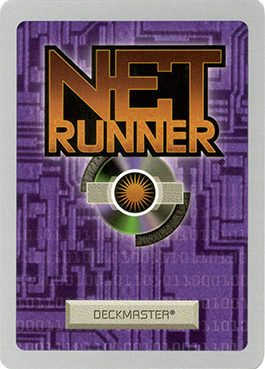
Netrunner is an out-of-print collectible card game (CCG) designed by Richard Garfield, the creator of Magic: The Gathering. It was published by Wizards of the Coast and introduced in April 1996. It was produced until 1999. The game took place in the setting for the Cyberpunk 2020 role-playing game (RPG), but it also drew from the broader cyberpunk genre.
Star Wars: Customizable Card Game (SW:CCG) is an out-of-print customizable card game based on the Star Wars fictional universe. It was created by Decipher, Inc., which also produced the Star Trek Customizable Card Game and The Lord of the Rings Trading Card Game. The game was produced from December 1995 until December 2001. Since 2002, the game has been maintained by the Star Wars CCG Players Committee, with new virtual cards being released every few months and the capability to play both in person and online.

Alderac Entertainment Group (AEG) is a publisher of family board game products. AEG was formed by Jolly Blackburn in 1993. Blackburn left the company in 1995 and the majority of the company is now owned by President & CEO John Zinser. The company is virtual and does not have a physical headquarters but it is legally domiciled in the city of Henderson, Nevada.
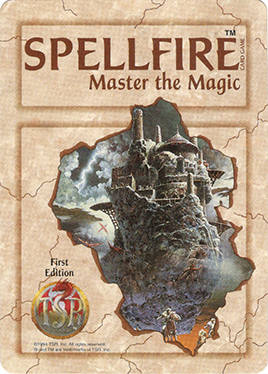
Spellfire: Master the Magic is an out-of-print collectible card game (CCG) created by TSR, Inc. and based on their popular Dungeons & Dragons role playing game. The game appeared first in April 1994, shortly after the introduction of Magic: The Gathering, in the wake of the success enjoyed by trading card games. It was the second CCG to be released, preceding Wizards of the Coast's second CCG Jyhad by two months. More than one dozen expansions for the game were released, and the final expansion was released in October 1997.

The Babylon 5 Collectible Card Game is an out-of-print collectible card game set in the Babylon 5 universe. It was published from 1997 to 2000. The game is ideally set for 4-5 players but can be played with a minimum of two players up to as many as 20 if using multiple Non-Aligned Factions and Home Factions. This CCG is distinct from most others of the genre for being specifically designed to be played by more than two players. The gameplay tends to have strong political elements encouraging significant player interaction aka "table talk" which is appropriate for a game based on a series which featured such a strong element of political intrigue. During its six-year existence under the Precedence Entertainment banner it released two core sets, five expansions sets and one revision set. There were two World Championships during that time. The game still continues to have a cult following as further expansions were made available online.
Vampire: The Eternal Struggle is a multiplayer collectible card game published by Wizards of the Coast (1994-1996), then White Wolf Publishing (1996-2010) and after several years of hiatus, by Black Chantry Productions (2018-present). It is set in the World of Darkness and is based on the Vampire: The Masquerade roleplaying game.

Middle-earth Collectible Card Game (MECCG) is an out-of-print collectible card game released by Iron Crown Enterprises in late 1995. It is the first CCG based on J.R.R. Tolkien's fictional universe of Middle-earth, with added content from ICE's Middle-earth Role Playing Game.
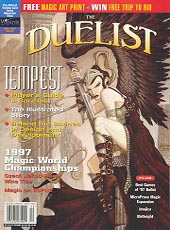
The Duelist was a trading card game magazine published by Wizards of the Coast.

SCRYE was a gaming magazine published from 1994 to April 2009 by Scrye, Inc. It was the longest-running periodical to have reported on the collectible card game hobby. It was also the leading print resource for secondary-market prices on Magic: The Gathering. The name, a registered trademark, is adapted from the Middle English word scry meaning "to foretell the future through a suitable medium".
Magic: The Gathering formats are various ways in which the Magic: The Gathering collectible card game can be played. Each format provides rules for deck construction and gameplay, with many confining the pool of permitted cards to those released in a specified group of Magic card sets. The Wizards Play Network, the governing body that oversees official Magic competitive play, categorizes its tournament formats into Constructed and Limited. Additionally, there are many casual formats with the Commander format being one of the most popular formats of the game.

Shadowrun: The Trading Card Game is an out-of-print collectible card game, released by FASA in August 1997 as a spin-off from FASA Corporation's Shadowrun role-playing game and used the same scenario, a cyberpunk setting with fantasy elements – an apocalyptic near-future Earth, with advanced technology which was also populated by magic and supernatural beings such as elves and dragons.
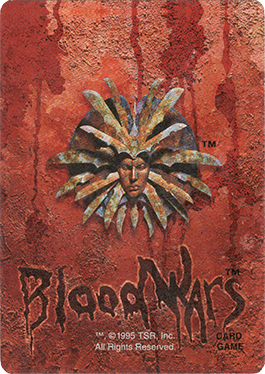
Blood Wars is an out-of-print collectible card game produced by TSR, based on the Planescape campaign setting from Dungeons & Dragons.

Young Jedi Collectible Card Game is an out-of-print collectible card game published by Decipher, Inc. that was released in May 1999. It was based on the events and characters of the movie The Phantom Menace in the Star Wars universe. Seven expansions were released before the game was discontinued in September 2001.
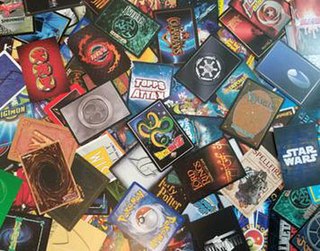
A collectible card game (CCG), also called a trading card game (TCG) among other names, is a type of card game that mixes strategic deck building elements with features of trading cards. It was introduced with Magic: The Gathering in 1993.

The BattleTech Trading Card Game is an out-of-print collectible card game (CCG) set in the BattleTech universe. The game was developed by Wizards of the Coast (WotC) for FASA and released in 1996. It went out of print after its last expansion, Crusade, in 1998.
A digital collectible card game (DCCG) or online collectible card game (OCCG) is a computer or video game that emulates collectible card games (CCG) and is typically played online or occasionally as a standalone video game. Many DCCGs are types of digital tabletop games and follow traditional card game-style rules, while some DCCGs use alternatives for cards and gameboards, such as icons, dice and avatars. Originally, DCCGs started out as replications of a CCG's physical counterpart, but many DCCGs have foregone a physical version and exclusively release as a video game, such as with Hearthstone.

Magic: Legends was an action role-playing video game based on the Magic: The Gathering collectible card game. It was developed by Cryptic Studios and published by Perfect World Entertainment. The game began an open beta for Microsoft Windows in March 2021, with plans for open release later that year as a free-to-play title on Windows, PlayStation 4, and Xbox One. The game's development ceased and the servers were shut down on October 31 of the same year.
References
- ↑ "Spider Solitaire Tips and Tricks - Understand the Layout and Objectives" . Retrieved 2024-01-03.
- ↑ "Magic Rarities: The Sixth Color Cards". Archived from the original on 2007-09-10. Retrieved 2007-09-23.
- ↑ Johnson, Christopher (1997-01-18). "Re: MTG-L Digest - 16 Jan 1997 to 17 Jan 1997". MTG-L@ORACLE.WIZARDS.COM (Mailing list). Archived from the original on July 18, 2011. Retrieved 2007-09-23.
- ↑ "INQUEST GAMER MAGAZINE DISCONTINUED: InQuest Gamer publication discontinued as of September 2007" (Press release). Wizard Entertainment. 2007-08-23. Archived from the original on 2007-09-30. Retrieved 2007-09-24.